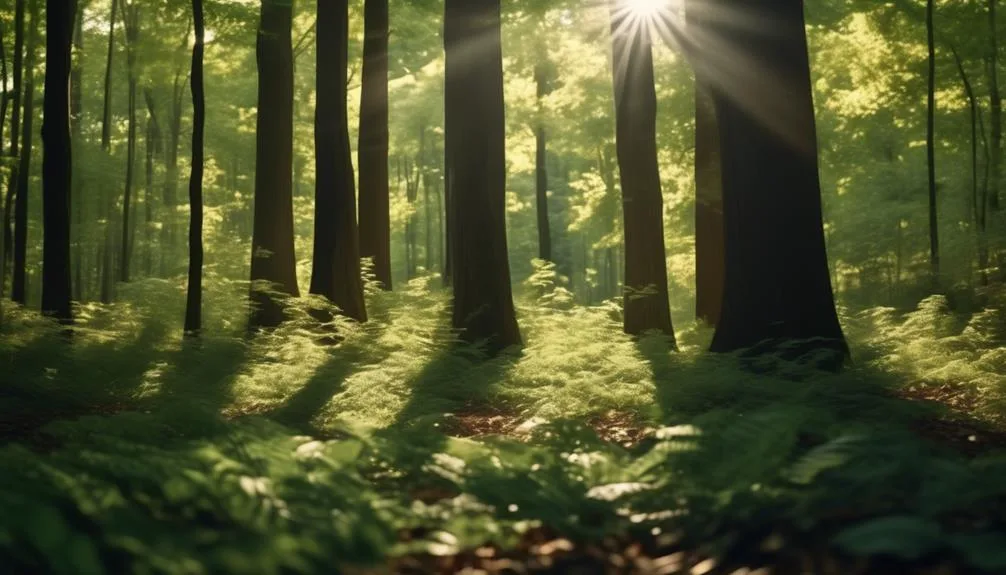Wondering where to find wild hickory trees in the Eastern United States? These trees are not as rare as you might think. They thrive in specific environments, from the Appalachian Mountains to riverbanks and wetlands.
But where exactly are they located? Stay tuned to learn about the prime locations and ecosystems where wild hickory trees flourish.
Discover the fascinating characteristics that make them an essential part of the natural landscape.
Eastern United States
If you're searching for wild hickory trees in the Eastern United States, start by exploring the dense forests and woodlands that blanket the region, where these elusive trees thrive.
The Eastern United States is home to a rich variety of wildlife, making it crucial to prioritize wildlife preservation in this area. The presence of wild hickory trees contributes significantly to the region's environmental impact, providing essential habitats and food sources for various species.
Wildlife preservation efforts are essential to maintain the delicate balance of the ecosystem and ensure the continued existence of these valuable trees. The Eastern United States has experienced environmental changes over the years, and the presence of wild hickory trees plays a vital role in maintaining a healthy and diverse environment.
Forested Areas
The dense forests and woodlands of the Eastern United States harbor a wealth of natural beauty, providing the ideal habitat for wild hickory trees to thrive and flourish. These forested areas aren't only essential for the survival of hickory trees but also serve as vital wildlife habitats.
They're biodiversity hotspots, teeming with a wide variety of plant and animal species. The intricate web of life within these forests creates a balanced ecosystem, where hickory trees play a crucial role in supporting diverse wildlife. From providing food and shelter for birds and small mammals to offering nesting sites for insects, the presence of hickory trees enriches these forested landscapes.
Exploring these areas not only offers the chance to admire the majestic hickory trees but also provides an opportunity to witness the interconnectedness of life within these biodiverse habitats.
Riverbanks and Wetlands
Nestled along the meandering riverbanks and within the lush expanses of wetlands, wild hickory trees thrive amidst the serene and fertile environment. These areas serve as rich wildlife habitats, making them ideal for spotting various species while on the hunt for wild hickory trees.
Reasons Riverbanks and Wetlands are Ideal for Finding Wild Hickory Trees:
- Abundant Water Supply: Riverbanks and wetlands provide the necessary moisture for hickory trees to flourish, attracting wildlife and creating an ecosystem that supports their growth.
- Rich Soil: The fertile soil in these areas offers the nutrients essential for the robust growth of hickory trees, making them highly prevalent in such environments.
- Diverse Wildlife: Riverbanks and wetlands are home to a diverse range of wildlife, providing an opportunity for nature enthusiasts to observe these creatures while seeking out wild hickory trees.
National Parks
Amidst the wide expanse of national parks, you'll discover an abundance of wild hickory trees flourishing in diverse and captivating landscapes. As you embark on national park exploration, keep a keen eye out for these majestic trees.
Many national parks offer the perfect opportunity for wildlife habitat observation, and hickory trees play a vital role in providing sustenance for various species. Look for shagbark hickory trees in the eastern national parks, recognizable by their distinct peeling bark and delicious nuts, which are a favorite among wildlife.
In the central and western parks, you may encounter the bitternut hickory, known for its slender, straight trunk and serrated leaves. These national parks not only offer breathtaking scenery but also serve as sanctuaries for the wild hickory trees, enriching your outdoor experience with their natural beauty.
Local Nature Reserves
Exploring local nature reserves presents an opportunity to encounter a diverse array of flora and fauna, providing an immersive experience in the natural world. Here's what you can expect when visiting these reserves:
- Tree Identification: Local nature reserves often feature a variety of tree species, making it an ideal place to practice tree identification skills. Look for distinct leaf shapes, bark textures, and overall tree structure to help identify different types of trees.
- Wildlife Spotting: Keep an eye out for local wildlife such as birds, small mammals, and insects. Nature reserves provide a habitat for a wide range of creatures, offering ample opportunities for wildlife spotting and observation.
- Trails and Interpretive Signs: Many nature reserves have well-marked trails and informative signs that can guide you through the area, providing valuable information about the local ecosystem and its inhabitants.
Conclusion
When seeking wild hickory trees, explore the eastern United States, where they thrive in forested areas, along riverbanks, and in national parks.
Keep an eye out for their distinctive bark and leaves, and immerse yourself in the beauty of these majestic trees.
Happy hickory hunting, and may your exploration of nature bring you joy and wonder.
Mark Hoffman is a dedicated arborist and tree care specialist with over a decade of experience. His love for trees began when he visited Yosemite National Park as a teenager and was awestruck by the giant sequoias. Mark pursued his passion by studying forestry at Michigan Technological University, where he earned a Bachelor of Science degree.
Since then, he has worked tirelessly in the field of arboriculture, helping to preserve and protect trees in his community. His expertise and dedication have made him a respected leader in the industry and a valuable resource for anyone seeking advice on tree care.
